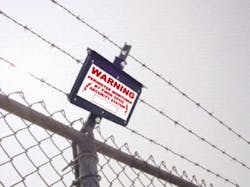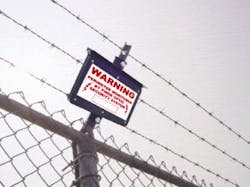By J.R. Wilson
ORISKANY, N.Y. — The days when a chain-link, razor-wire or even electric fence — regardless of height — would deter intruders is long past. Yet the perimeter fence remains an important factor in the security of military facilities.
The evolution of fiber-optic technology, however, has brought new capabilities to traditional fencing that allow engineers at Fiber Instrument Sales (FIS) in Oriskany, N.Y., to turn the fence into a giant sensor that can warn security personnel immediately of any breach, pinpoint the location, and even direct remote cameras and other sensors.
Recently, for example, FIS engineers looped one fiber-optic line four times around a jet-fuel depot at Pease Air National Guard Base in Newington, N.H.
"This is an affordable, mid-level perimeter-security capability," says Greg Bowie, director of security for FIS. "Inside the perimeter, you also may have motion detectors, cameras, guards, etc. But the Fiber Fence provides a first line of defense.
"We've taken fiber-optic and OTDR (optical time-domain reflectometer) technology and incorporated them into our Fiber Fence," Bowie continues. "We've also designed a piece of equipment we call Mouse Trips to work with that. No power is required around the perimeter, not even for the Mouse Trips."
In its simplest form, the Fiber Fence is one, two, or three 900-micron strands of fiber-optic cable. When an intruder bends or breaks it, an alarm sounds, Bowie explains. A 900-micron fiber is about nine times the diameter of a human hair.
The Mouse Trip can be set to trip at as little as 5 ounces of pressure or as much as two pounds to minimize nuisance alarms due to wind or blown debris. It simulates a break in the fence and triggers the alarm. Software shows where the break is happening so security personnel can dispatch human guards or bring a pan-tilt zoom camera to bear.
"When the Mouse Trip goes off, a spring-loaded plunger is activated that bends the fiber, which reduces the level of light continuing on to the receiver end," Bowie explains. "That attenuated light sets off the alarm; the OTDR then can measure the distance to the bend in the fiber created by the Mouse Trip. The Fiber Fence 1000 will only see to the first Mouse Trip; the Fiber Fence 2000 will see through three Mouse Trips that are set off simultaneously."
The only power is at the control unit, which installers can rack-mount or install in a desktop configuration in a controlled environment. The control unit also powers the laser light running through the fiber.
Because the Fiber Fence itself requires no power, it can be used in remote areas or extended to great lengths.
FIS offers the fence in three basic configurations:
- Fiber Fence 100 for small perimeters, which does not provide the location of alarms, costs $2,995;
- Fiber Fence 1000, which has alarm-location designation and is for as far as five miles, costs $9,995; and
- Fiber Fence 2000, which is for as far as 50 miles, costs $45,000.
The Mouse Trips cost $69 each; the cost of the OTDR cards were not available at presstime. The fiber-optic lines are available in any length or can loop around a site several times, thus a 50-mile length could provide two strands around a 25-mile perimeter.
"On the 2000, additional OTDR cards can be put into a single control unit to handle separate fibers if you want, although if you are within the 50-mile limit, it would be cheaper to just loop it," Bowie says, adding the 1000, with multiple loops, has been the most popular model.
The control unit fits into an existing security system and alarms can reflect on other security screens as well.
The company also offers photo beam detectors, cameras, digital video recorders, proximity readers, and other related equipment that can tie into a Fiber Fence to provide a turnkey system or expand an existing security system.
The Fiber Fence has been tested and demonstrated in a wide range of environments, including continued operations under several feet of snow and at long duration subzero temperatures.
For more information contact FIS online at www.fiber-fence.com





